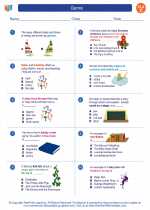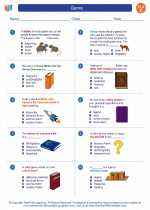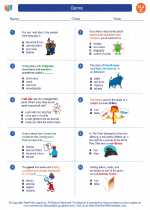Genre
Historical fiction, Science fiction, biography, autobiography, folktale, fairy tale, and poetry.
◂English Language Arts Worksheets and Study Guides Third Grade. Genre
The resources above cover the following skills:
Reading Standards for Literature
Key Ideas and Details
Recount stories, including fables, folktales, and myths from diverse cultures; determine the central message, lesson, or moral and explain how it is conveyed through key details in the text. [RL.3.2]
Craft and Structure
Refer to parts of stories, dramas, and poems when writing or speaking about a text, using terms such as chapter, scene, and stanza; describe how each successive part builds on earlier sections. [RL.3.5]
Range of Reading and Level of Text Complexity
By the end of the year, read and comprehend literature, including stories, dramas, and poetry, at the high end of the Grades 2-3 text complexity band independently and proficiently. [RL.3.10]
Reading Standards for Informational Text
Key Ideas and Details
Describe the relationship between a series of historical events, scientific ideas or concepts, or steps in technical procedures in a text, using language that pertains to time, sequence, and cause and effect. [RI.3.3]
Range of Reading and Level of Text Complexity
By the end of the year, read and comprehend informational texts, including history/social studies, science, and technical texts, at the high end of the Grades 2-3 text complexity band independently and proficiently. [RI.3.10]
Reading Standards: Foundational Skills
Fluency
Read with sufficient accuracy and fluency to support comprehension. [RF.3.4]
Read on-level prose and poetry orally with accuracy, appropriate rate, and expression on successive readings. [RF.3.4b]



